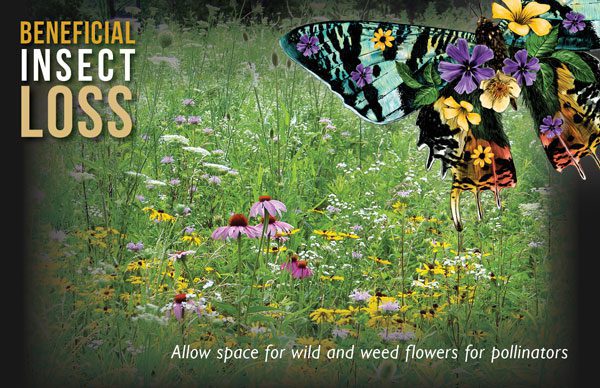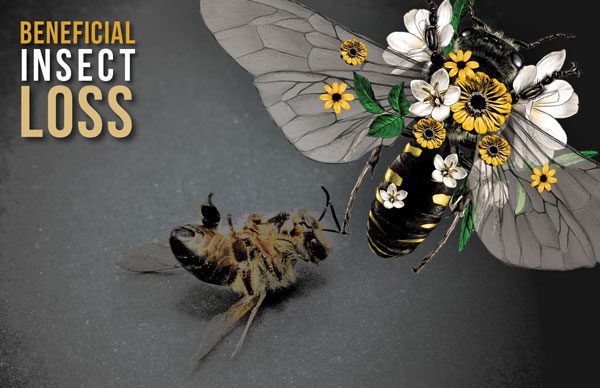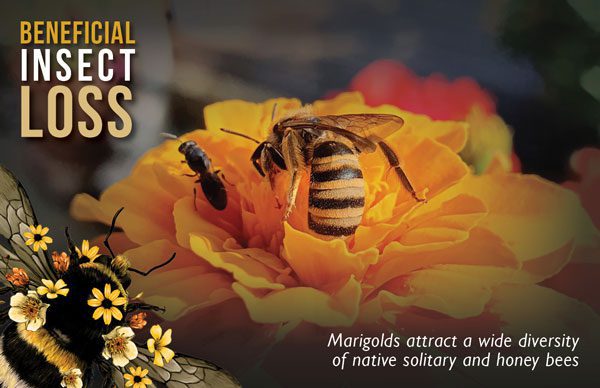Most gardeners are well aware that insect populations are in trouble in many countries around the world. However, the extent and impacts of such losses could be much worse than many of us imagined. Based on recent research studies, it appears the decline in numbers and diversity is accelerating, so it’s worth examining why this is happening and what we as individual gardeners can do about it.
Insect populations wax and wane for a variety of reasons. Concerns raised by many scientists revolve around the scale and common causes. Evidence of geographic-specific declines have been reported in many studies, but several key factors appear to be simultaneously affecting global insect populations and biodiversity.
Major Causes of Insect Decline
In a 2019 global review, “Worldwide decline of the entomofauna: A review of its drivers,” scientists revealed the leading causes of insect declines in recent decades based on examining data in 73 different studies. The most influential factor is habitat loss from intensive agriculture and urbanization, particularly over the last 60 years. Next on the list is agrochemical pollutants primarily from synthetic pesticides and fertilizers; biological factors that include introduced species and pathogens; and climate change.

The review sheds light on the alarming status of insect biodiversity around the world with nearly half the species in rapid decline and a third in threat of extinction. The review states “The conclusion is clear: unless we change our ways of producing food, insects as a whole will go down the path of extinction in a few decades.” A sobering thought, indeed.
While these factors may be influential on insect decline, recent climate events take this dire situation to a whole new level. Catastrophic fires in Australia along with years of drought have wiped out much of the habitat insects require for shelter, breeding, and forage. Flowering plants and trees provide nectar and pollen as food sources for a wide range of insect species. With millions of hectares burned or dead from lack of rain, insect populations across diverse ecosystems have not only been wiped out, but their closest forage supplies are also destroyed.
Bees, for example, travel on average about 4 kilometers or 2.5 miles from the hive to find food in the local flora. While they can fly longer distances, their preference is to visit sources closer to the colony where flowers are in abundance, as this conserves their energy. With hundreds of native and commercial beehives destroyed in these recent events, on top of other issues bees are dealing with including diseases and poisoning from chemicals, surviving bees may now be starving due to habitat loss on a grand scale. The nearest food may be further than they are capable of flying. Our insect populations need healthy ecosystems to survive and thrive.
Working Towards Solutions
Many research scientists involved in the studies in this global review take the stance that a multi-faceted approach is needed for insect populations to recover and maintain biodiversity. This requires a big picture approach. To mitigate the loss of habitat and insect decline, change needs to happen in the environment and particularly in the farming industry. Actions that can make a positive difference include preserving wildlife corridors; insect-friendly agricultural practices; banning or minimizing pesticide use; farmer education regarding sustainable agricultural practices; and ecosystem regeneration.

Most of the advice conventional farmers use to make decisions on pesticide use comes from both government agriculture departments and the agribusiness industry. Both have a vested interest in profits, whereas scientists can share the impact of such decisions, and biological farming educators can provide hands-on advice on sustainable and eco-friendly alternative strategies that boost farm income.
The global review urges “a rethinking of current agricultural practices, in particular, a serious reduction in pesticide usage and its substitution with more sustainable, ecologically-based practices, is urgently needed to slow or reverse current trends, allow the recovery of declining insect populations and safeguard the vital ecosystem services they provide. In addition, effective remediation technologies should be applied to clean polluted waters in both agricultural and urban environments.”
The report has advice that farmers and market gardeners could take on board to reduce their use of chemicals while managing pest problems and increasing yields. The researchers state “Habitat restoration, coupled with a drastic reduction in agrochemical inputs and agricultural ‘redesign’ is probably the most effective way to stop further declines, particularly in areas under intensive agriculture. For example, flower and grassland strips established at the field edge enhance the abundance of wild pollinators, and rotation of crops with clover boosts the abundance and diversity of bumblebees, which in turn boost crop yield and farm profitability. These ‘ecological engineering’ tactics not only favor pollinators but also conserve natural insect enemies that are essential for keeping at bay the herbivorous pest species of many crops.” These principles can also be applied in small-scale growing applications, including backyards and community gardens.
Positive Action Required
The continuing increase in the human population and demand for industrial-scale farming uses vast amounts of land, energy, and resources. The farmed dairy and meat industries alone contribute to this ever-growing problem of habitat destruction to provide food that offers insects no significant benefits. Whereas growing plant-based crops and diets focused on consuming fruits, vegetables, and herbs provide large numbers of flowers for insects to eat. The choices we make and what we eat is food for thought alone.

While we may not have direct control over government decisions on tackling some of these issues, we can demand political action, eat fewer intensively farmed meat and dairy products, consume more organic food, and take action at a local level.
For example, new housing developments are typically associated with loss of habitat. However, I’ve seen in my local community that residents have voiced their concerns and had positive outcomes that have ensured new estates include vegetation corridors to encourage insects and wildlife to repopulate.
Working with our neighbors and communities to revegetate our suburbs with native flora via local Landcare groups and attending working bees at community gardens can also make a positive difference. Many councils offer free native plants to taxpayers every year, and adding these to our verge gardens or front yards can provide vital habitat for hungry pollinators. We can also encourage our local councils to use natural alternatives to chemical herbicides and insecticides used in public spaces.
Urban Opportunities for Attracting Beneficial Insects
A 2015 UK study* involving a team of over 50 people spent two years collecting data on pollinating insects and flowering plants in various cities and rural areas. Although expanding urbanization has been established as one of the major causes of insect decline due to the loss of food and nesting sites, the researchers found that urban habitats can house significant numbers of pollinator species in a condensed area. For example, a single garden in the UK recorded 35% of the country’s hoverfly species – an insect vital for both pollination and predation on pest insect populations. Other studies involved in this research revealed a concentration of specific types of bees in urban neighborhoods.
This report found that in urban areas, public community gardens, and home gardens could provide a vital sanctuary and chemical-free flowering species for pollinators. The study established that if “urban areas are able to support good populations of insect pollinators, they could act as important source areas, refuges, and corridors of favorable habitat.”
The researchers, led by scientist Katherine Baldock from the University of Bristol, were able to identify which flowers were visited most often by bees, hoverflies, and other pollinating insects. Some of these included flowering weed species, including dandelions. As gardeners, we can play a vital role in choosing plants that are most attractive to pollinators and creating a chemical-free environment for them to forage.
While native plants are ideal for including in any bee-friendly garden, the researchers found some of the most attractive flowers included herbs like lavender and borage as well as marigolds and butterfly bushes. The research also highlighted the importance of growing a diverse variety of flowering species throughout the seasons, because not all pollinating insects can access the pollen and nectar in every plant. Just like we have our favorite cuisine, some pollinators are very species-specific too.
Urban Threats to Insects
However, urban areas also have a concentration of hazards for these vital beneficial insects. “The presence of Wi-Fi, cellphone towers, and EMF from human technology can cause debilitating harm to bee populations. Radiation and electric waves damage and interfere with the bees’ natural compass. This interference makes it very challenging for them to travel correctly or safely” says Molly Brecken of the Bee Keeper Center. Mobile phone towers are installed in most suburbs and especially those with high-density living close to cities.

Molly highlights another danger insects are exposed to. “The widespread use of pesticides that contain neonicotinoids in commercial nurseries can disrupt their natural patterns and behavior, as well as their ability to forage efficiently.” Many home gardeners also use a wide range of chemicals on their lawns and gardens.
A 2013 FOE US Report** cautions that “unfortunately, pollinator-friendly nursery plants sold to unsuspecting consumers carry neither a list of pesticides used nor do they carry a warning that these pesticides could harm pollinators.” Many gardeners may be innocently buying bee-attracting plants with the best of intentions but in reality, bringing home plants that have been pre-treated with neonicotinoid pesticides. These toxic poisons may harm or kill bees and other pollinators and beneficial insects that are critically important to our food production and healthy ecosystems.
Consumers can avoid these issues by purchasing organic seeds and raising their seedlings or buying plants from sources where they can ascertain no chemicals have been used. Many Permaculture and seed saving groups, gardening clubs, and organic gardeners in local communities are a good starting point for obtaining organically grown plants and seeds. By avoiding all chemicals and using integrated pest management strategies instead, harmful herbicides, insecticides, and other toxic substances can be eliminated from home gardens. This makes them safer places for insects, wildlife, humans, and pets.
The Big Picture – Systemic Changes Needed
The research paper ‘Moving on from the insect apocalypse narrative: engaging with evidence-based insect conservation’ provides insight into other imbalances that occur stating: “Habitat removal and landscape modification are also key drivers of change in local insect populations. In particular, the increasing amount of land converted to homogeneous crop production can provide ideal environments for more pest insect outbreaks and have detrimental effects on populations of beneficial insects (Haddad et al. 2011; Nicholls and Altieri 2013). Broad-scale land clearing and agricultural intensification reduce the diversity of habitats and resources available to insects at the landscape scale (Tscharntke et al. 2012).”
It’s arguable that to reverse habitat loss, regenerate local environments, increase the diversity of species, and prevent toxic chemicals in our landscapes requires systemic change at government and local levels in many sectors. We may not be able to effect big changes, but regardless of where we live – in urban city areas, semi-rural or rural zones, we can each make a positive difference in a small way. We can play a part in improving the environment for our vital pollinators and beneficial insects in our gardens and communities by supporting local initiatives, avoiding chemicals, and planting more native species.
Home Gardens as Havens
My work involves helping gardeners design and plant small urban spaces to grow food. As I drive around new estates with large homes taking up the majority of the footprint on tiny blocks, I often see fake turf and fences with very little in the way of planting front or back. Many homes have NO gardens at all! No self-respecting bees and beneficial insects will venture into desolate landscapes devoid of habitat, shade, water, shelter, and flowering species with nectar and pollen. Even those attempting to grow small kitchen gardens often try to do so in isolation of providing such necessary elements in their design. This is one of the reasons many home gardeners in such situations struggle with pollination and achieving successful harvests.

When I first started my kitchen garden on land that had previously had chemical use for horticultural purposes, I knew I had to work hard to restore a healthy ecosystem and environment. I built soil from scratch with raised garden beds, never used any chemicals, carefully selected locally grown heirloom and organically grown seeds, and planted a diverse range of flowering species and natives. I included bee hotels, shallow bee baths and birdbaths, planted fruit trees for shade, and patiently waited for insects and birds to move in.
The first year, I noticed bees were pollinating my crops, but there were virtually no pest insects. It took three years before I noticed the perfect equilibrium appear in my kitchen garden. With the fruit tree canopies in place, underplanted with colorful perennials, annuals, herbs, and natives, the balance was evident. Birds started to visit in ever-increasing numbers and seek out shade and food. They also provide free pest management services. The garden is never without flowers, even in winter. The diversity of insect life exploded with dozens of different native and solitary bees as well as honeybees devouring pollen and nectar all over the garden year-round. Sometimes, the sound of hundreds of bees is deafening with their buzz in just one perennial basil plant.
I’ve sacrificed some space just so my insect populations can have their domain to feed, drink, bathe, and shelter. I allow little wild areas for ‘weeds’ like ageratum or blue tops to self-sow. Their bright blueish purple flowers provide a year-round feast for greedy pollinators seeking safe food. I allow edibles like basils, parsley, mints, thyme, oregano, sages, rocket, mustard, broccoli, and nasturtiums to flower and go to seed. I’ve often witnessed eight different insects on the one parsley plant in flower at the same time: different bee species, hoverflies, and other pollinators and beneficial insects. As a result, I have no problem with successful pollination and reap abundant harvests.
Likewise, vegetables in flower not only provide food for our kitchen but also play host to beneficial insects seeking nectar and pollen. The predatory insect to pest insect ratio is in a beautiful balance, so I rarely need to intervene to “manage” pest problems. Spiders, wasps, hoverflies, dragonflies, ladybirds, mantids, and many more beneficial insects take care of business before I’ve even noticed pests in residence. Creating a safe environment in which to grow food for ourselves has a flow-on benefit for insects as well.
With bees encountering so many challenges, growing chemical-free forage in our home gardens has never been so important. For home gardeners like myself, I rely on local pollinators and beneficial insects to ensure I get a good harvest and to maintain a healthy balance and ecosystem. The productivity of our kitchen garden has increased each year, and so do the bees and beneficial insect numbers and varieties. I’m a big believer that ‘if you build it, they will come’!
Being a good steward of our plot or garden, be it big or small, can make a difference to the beneficial insects and pollinators that help put food on our table. Perhaps our legacy for the next generation is to ensure we do our bit to safeguard these tiny lives that have such a big impact on our own.
* Baldock KCR et al. 2015 Where is the UK’s pollinator biodiversity? The importance of urban areas for flower-visiting insects. Proc. R. Soc. B 282: 20142849.
** FOE US Report ‘Gardeners Beware: Bee-Toxic Pesticides Found in “Bee-Friendly” Plants Sold at Garden Centers Nationwide’ 2013 [go.aws/2SKXfp1]